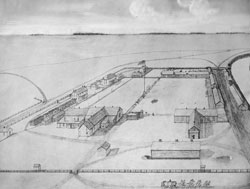When news of the Santee Conflict reached Ft. Abercrombie on August 20, 1862, earthen breastworks described as “a fortification for the quarters was made by using the barrels of pork and corned beef and flour, mingled with earth and cordwood” was erected. Work on the defensive perimeter surrounding the fort’s buildings continued throughout the six week Dakota siege. By September 23, the fort had been strengthened with cordwood and hewn timbers - a breastwork built around the barracks which raised to a height of 8 ft. This was capped by hewn timbers 8 inches square, with loopholes between them from which fire could be directed against an attacking enemy. Bastions for the 12-pound cannons were established at three corner locations.
News was coming in every day, that Fort Ridgely was being attacked, that white settlers to the east and south were being massacred, and that New Ulm was attacked. It was also reported that a party of hostile Indians, many young men, had gone north on a war party, there being white people there and also a fort [Fort Abercrombie] toward which they went. Gabriel Renville, or Tiwakan, meaning Sacred Lodge, (1825 - 1892)
 The fiercest fighting at Fort Abercrombie took place in September, when Dakota warriors got into the stable and a “hot, ten-minute fight” ensued. Other confrontations took place on the west side of the commissary, located on the north side of the fort. On September 23, 1862, five hundred volunteer soldiers under the command of Captain Burger arrived to reinforce the garrison, and the siege of Fort Abercrombie was lifted.
The fiercest fighting at Fort Abercrombie took place in September, when Dakota warriors got into the stable and a “hot, ten-minute fight” ensued. Other confrontations took place on the west side of the commissary, located on the north side of the fort. On September 23, 1862, five hundred volunteer soldiers under the command of Captain Burger arrived to reinforce the garrison, and the siege of Fort Abercrombie was lifted.
The forces of the United States, including volunteer militias, struck back at the Dakota, and rounded up thousands of men, women and children. On October 25, 1862, military tribunals began trying forty Dakota at a time. 307 Dakota were condemned to death by the tribunals, but the cases were referred to Washington, DC for review. On December 6, 1862, President Lincoln approved the death sentence for 39 Dakota and commuted the sentences for 263 Dakota. The executions were carried out in Mankato, Minnesota on December 26, 1862. This was the largest mass execution in American history.
 Abercrombie would be eventually be tied to the outside world via the railroad. In 1870, supply route ended at the railhead in St. Cloud, and thence by wagons. A tri-weekly stage from St. Cloud kept the fort connected, although by a three day trip. By 1875, supplies and communication with headquarters in Saint Paul were via the Saint Paul and Pacific Railroad to Breckenridge, a distance of 217 miles, thence ambulance or stage to the fort, 13 miles.
Abercrombie would be eventually be tied to the outside world via the railroad. In 1870, supply route ended at the railhead in St. Cloud, and thence by wagons. A tri-weekly stage from St. Cloud kept the fort connected, although by a three day trip. By 1875, supplies and communication with headquarters in Saint Paul were via the Saint Paul and Pacific Railroad to Breckenridge, a distance of 217 miles, thence ambulance or stage to the fort, 13 miles.
As Abercrombie was no longer needed from a military standpoint, the military reservation was abandoned and opened up to settlers, who had already begun locating on the reservation in Minnesota before 1876. The legislature of Minnesota requested that the portion of the reservation in Minnesota,
Congress to vacate that portion of the military reservation at Fort Abercrombie which lies on the east side of Red River, in the State of Minnesota, and to open the same to settlement and occupation under the homestead and pre-emption laws. Military Reservation at Fort Abercrombie, Dakota Territory, 44th Congress, 1st Session, House of Representatives, Miscellaneous Document No. 137, (Washington, DC: General Printing Office, 1876).
Address:
935 Broadway North
Abercrombie, ND 58001
Get Directions
Tuesday After Labor Day–Memorial Weekend Friday
Open for events, school tours, rentals, and by appointment.
Memorial Weekend Saturday–Labor Day
9 a.m.–5 p.m.
Daily
Site grounds are open year-round.
Contact Fort Abercrombie:
phone: 701.553.8513
email: shsaber@nd.gov
Contact SHSND:
phone: 701.328.2666
email: history@nd.gov